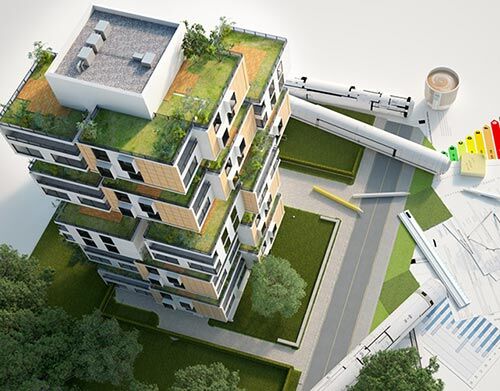
As global efforts to combat climate change intensify, sustainable development has become a primary focus in urban planning. Among the most promising advancements is the rise of smart buildings, which integrate technology and innovation to reduce energy consumption, minimise waste, and create healthier environments. These structures offer a transformative path toward sustainability, combining efficiency with adaptability in ways that traditional buildings cannot match.
What Makes a Building Smart?
A smart building is more than a collection of bricks and mortar; it incorporates technology to monitor, manage, and optimise its functions. Sensors, IoT devices, and advanced software work together to regulate everything from lighting to climate control. At the core of these systems is the building management system (BMS), which provides a centralised platform for managing energy usage and other key operations. These systems ensure that resources are used responsibly while maintaining occupant comfort.
How Smart Buildings Drive Sustainability
One of the most significant advantages of smart buildings is their ability to reduce energy consumption. Heating, ventilation, and air conditioning (HVAC) systems account for a substantial portion of a building’s energy use. A well-integrated building automation system can adjust HVAC settings in real-time based on occupancy levels, weather conditions, and time of day, minimising waste.
Lighting is another area where automation plays a crucial role. Smart lighting systems can dim or switch off lights in unoccupied areas, reducing electricity usage without compromising functionality. Beyond energy efficiency, these innovations also improve cost savings for building owners and operators.
Water conservation is equally important in sustainable architecture. Smart sensors detect leaks or inefficiencies in plumbing systems, addressing issues before they become costly or environmentally damaging. This proactive approach reduces water wastage and supports broader conservation efforts.
The Role of Data in Smart Buildings
Data collection and analysis are at the heart of every smart building. Sensors continuously gather information on energy use, occupancy, and equipment performance. This data is then analysed to identify patterns, inefficiencies, and areas for improvement. For instance, a building automation system can detect when equipment is operating outside of optimal conditions, prompting maintenance before a breakdown occurs. This predictive capability not only reduces downtime but also extends the lifespan of expensive equipment.
Smart buildings also empower tenants and building managers with real-time insights. Dashboards and mobile apps provide detailed reports, enabling informed decisions about energy use and other building functions. This transparency fosters accountability and encourages sustainable behaviours among occupants.
Adapting to Renewable Energy Sources
As renewable energy technologies become more accessible, smart buildings are ideally positioned to take full advantage of these resources. Solar panels, wind turbines, and geothermal systems can be seamlessly integrated into a smart building management system, ensuring efficient use and storage of clean energy. Excess energy can even be fed back into the grid, contributing to a more sustainable energy ecosystem.
Energy storage systems, such as batteries, further enhance a building’s energy independence. These systems store energy during off-peak hours or when renewable sources generate surplus power, ensuring a steady supply when demand peaks or renewable generation dips.
Creating Healthier Indoor Environments
Sustainability isn’t just about reducing resource use; it’s also about creating spaces that prioritise human well-being. Smart buildings achieve this by monitoring indoor air quality, temperature, and humidity levels. Advanced filtration systems remove pollutants, allergens, and harmful particles, promoting healthier living and working conditions. These features are especially valuable in urban areas, where air quality is often compromised.
Smart buildings can also adapt their environments to support mental and physical health. Adjustable lighting systems mimic natural daylight cycles, enhancing mood and productivity. Meanwhile, automated climate controls create a consistent, comfortable environment that reduces stress and fatigue.
Overcoming Challenges to Adoption
While the benefits of smart buildings are undeniable, there are challenges to widespread adoption. High initial costs, a lack of standardisation, and concerns about data privacy can deter building owners and developers from investing in smart technologies. Educating stakeholders about the long-term savings and environmental benefits of these systems is critical to addressing these barriers.
Governments and industry bodies can play a pivotal role by introducing incentives, such as tax breaks or grants, to offset installation costs. Collaboration between technology providers, architects, and engineers can also help streamline the implementation of smart solutions, making them more accessible and cost-effective.
Future Prospects for Smart Buildings
The potential for smart buildings extends far beyond energy efficiency. As urban populations grow and climate challenges become more pressing, these structures will serve as integral components of sustainable cities. With innovations such as AI-driven optimisation and advanced robotics on the horizon, the capabilities of smart buildings will continue to expand.
For instance, integrating AI with a building management system can enable buildings to learn and adapt to occupant behaviours over time, further enhancing efficiency. Autonomous maintenance systems may soon become commonplace, performing repairs or upgrades without human intervention.
Smart buildings represent a forward-thinking approach to sustainability, combining technology and innovation to address some of the most pressing challenges of our time. By integrating advanced systems like building automation and smart building management systems, these structures reduce environmental impact while improving quality of life for occupants. As the world strives for a greener future, smart buildings are set to play a pivotal role in creating sustainable, resilient urban environments.
By embracing these technologies today, we can lay the foundation for a future where environmental responsibility and human comfort go hand in hand. The smarter we build, the more sustainable our future will be.
